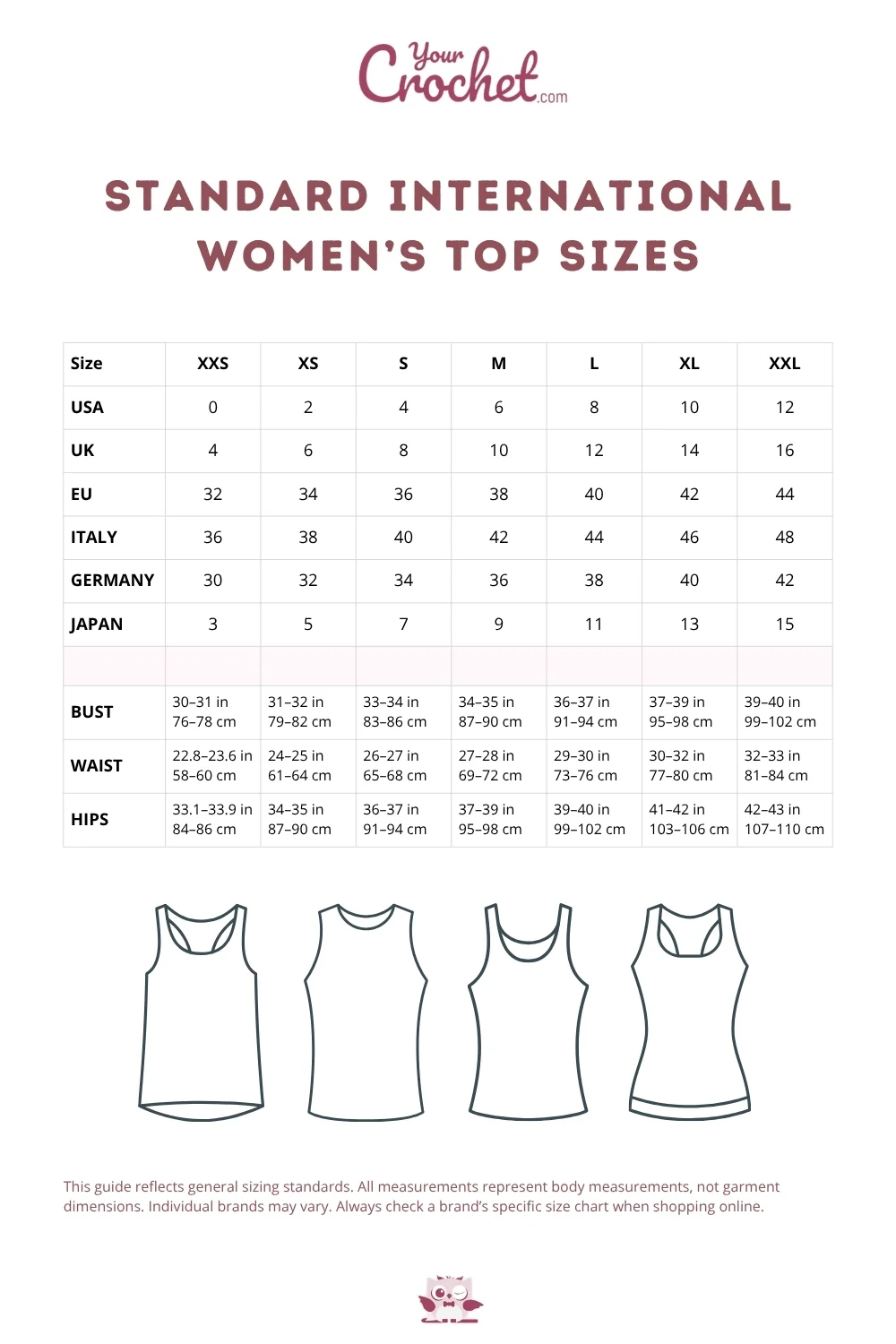In this article:
Have you ever made a crochet garment only to find out it’s too big or too small for you? If you have, you’re not alone. Fortunately, this very common problem is easy to fix! Of course, it may be the case of uneven tension or not hitting the right gauge, but often it’s simply choosing the wrong size. Our printable size charts and measuring guide will help you determine which size you should aim for and how to properly take measurements.
Whether you’re designing a completely new garment or adjusting the size of a favorite pattern, we’ve got your back.
How to Measure Yourself for a Project
Correct measurements are the basis of a well-fitted garment, so learning how to take them properly is worth your time and effort. Once you know what dimensions your body has, you can design or adjust crochet patterns to fit it better.
The points of measurement should be more than enough to design any crochet top, cardigan, or sweater. The hip circumference will be important in longer tops, tunics, or dresses.
What tools do I need?
You need an elastic measuring tape and a piece of paper to write the measurements on. Nothing fancy!
Tips for the Best Results
These tips will ensure your measurements are taken professionally.
- Measure yourself over underwear only – both measuring over clothing and naked will distort the results. If you usually wear a bra, leave it on, but choose a soft one. Avoid thick, padded bras that enlarge the bust and change its shape too much. Go for natural, but lifted.
- Keep the measuring tape snug, but not tight – the tape should touch your body, but not squeeze it. It shouldn’t fall once you wrap it around. When measuring your chest, wrap the tape around and take a big breath. Let it expand, then tighten it slightly and write down the measurement.
- Keep the arm slightly bent when measuring the arm length – if you measure a straightened arm, the sleeves may end up too short.
- Get help – to get the best results, we should stand straight and relaxed, with arms down. Ask someone else to measure you (or at least the back).
- Update your measurements regularly – our bodies change, and so do our measurements. Make sure which size you are before starting a new project.
Measuring Points
These measurements will help you design most crochet garments.

- Chest/Bust – Measure around the fullest part of the chest, but ensure the tape isn’t too tight.
- Center Back Neck-to-Wrist – Straighten the arm and measure from the back base of the neck, across the shoulder, to the wrist.
- Back Waist Length – Measure from the most prominent bone at the base of the neck to the natural waistline.
- Cross Back – From shoulder to shoulder.
- Arm Length – Measure from armpit to wrist with a slightly bent arm.
- Upper Arm – Measure around the widest section of the upper arm above the elbow.
- Armhole Depth – From the top of the shoulder down to the armpit.
- Waist – Measure around your waist at the smallest circumference, usually just above the belly button.
- Hips – Measure around the widest part of your lower hip.
Print it or Pin it
Save this file to print on your own, or pin it to your Pinterest board.

Standard Women’s Body Size Chart
This table is based on standards from the Craft Yarn Council, which represents leading brands and companies in the yarn industry.
The numbers in this section apply to the body, not the finished garment. However, this is your starting point, from which you add positive or negative ease in specific garment designs.
| Size | XS | S | M | L | XL | XXL |
| Chest | 28–30 in 71–76 cm | 32–34 in 81–86 cm | 36–38 in 91.5–96.5 cm | 40–42 in 101.5–106.5 cm | 44–46 in 111.5–117 cm | 48–50 in 122–127 cm |
| Center Back Neck–to–Wrist | 26–26½ in 66–68.5 cm | 27–27½ in 68.5–70 cm | 28–28½ in 71–72.5 cm | 29–29½ in 73.5–75 cm | 29–29½ in 73.5–75 cm | 30–30½ in 76.5–77.5 cm |
| Back Waist | 16½ in 42 cm | 17 in 43 cm | 17¼ in 43.5 cm | 17½ in 44.5 cm | 17¾ in 45 cm | 18 in 45.5 cm |
| Cross Back (Shoulder to shoulder) | 14–14½ in 35.5–37 cm | 14½–15 in 37–38 cm | 15½–16 in 39.5–40.5 cm | 16½–17 in 42–43 cm | 17½ in 44.5 cm | 18 in 45.5 cm |
| Arm Length to Underarm | 16½ in 42 cm | 17 in 43 cm | 17 in 43 cm | 17½ in 44.5 cm | 17½ in 44.5 cm | 18 in 45.5 cm |
| Upper arm | 9¾ in 25 cm | 10¼ in 26 cm | 11 in 28 cm | 12 in 30.5 cm | 13½ in 34.5 cm | 15½ in 39.5 cm |
| Armhole depth | 6–6½ in 15.5–16.5 cm | – 6½–7 in 16.5–17.5 cm | 7–7½ in 17.5–19 cm | 7½–8 in 19–20.5 cm | 8–8½ in 20.5–21.5 cm | 8½–9 in 21.5–23 cm |
| Waist | 23–24 in 58.5–61 cm | 25–26½ in 63.5–67.5 cm | 28–30 in 71–76 cm | 32–34 in 81.5–86.5 cm | 36–38 in 91.5–96.5 cm | 40–42 in 101.5–106.5 cm |
| Hips | 33–34 in 83.5–86 cm | 35–36 in 89–91.5 cm | 38–40 in 96.5–101.5 cm | 42–44 in 106.5–111.5 cm | 46–48 in 116.5–122 cm | 52–53 in 132-134.5 cm |
To see the measurements for the sizes 3XL, 4XL, and 5XL, visit craftyarncouncil.com.
Print it or Pin it
Save this file to print on your own, or pin it to your Pinterest board.
Women’s Size Chart in Inches
This chart shows values in imperial units.

Women’s Size Chart in Centimeters
This chart shows values in metric units.

Women’s International Clothing Size Chart
The table below shows standard international sizes and how they correspond with each other between countries. While you may be a 6 in the USA, you are a 10 in the UK. The given numbers are intended for general guidance, and the sizes between brands may vary. Always check the brand’s specific size guide when shopping online.
Most crochet designers have a dedicated size chart for the specific project, so always consult it to get the best results.
The numbers in the last three columns (Bust, Waist, Hips) apply to the body dimensions, not the finished garment.
| Size | USA | UK | EU | Italy | Germany | Japan | Bust | Waist | Hips |
|---|---|---|---|---|---|---|---|---|---|
| XXS | 0 | 4 | 32 | 36 | 30 | 3 | 30–31 in 76–78 cm | 22.8–23.6 in 58–60 cm | 33.1–33.9 in 84–86 cm |
| XS | 2 | 6 | 34 | 38 | 32 | 5 | 31–32 in 79–82 cm | 24–25 in 61–64 cm | 34–35 in 87–90 cm |
| S | 4 | 8 | 36 | 40 | 34 | 7 | 33–34 in 83–86 cm | 26–27 in 65–68 cm | 36–37 in 91–94 cm |
| M | 6 | 10 | 38 | 42 | 36 | 9 | 34–35 in 87–90 cm | 27–28 in 69–72 cm | 37–39 in 95–98 cm |
| L | 8 | 12 | 40 | 44 | 38 | 11 | 36–37 in 91–94 cm | 29–30 in 73–76 cm | 39–40 in 99–102 cm |
| XL | 10 | 14 | 42 | 46 | 40 | 13 | 37–39 in 95–98 cm | 30–32 in 77–80 cm | 41–42 in 103–106 cm |
| XXL | 12 | 16 | 44 | 48 | 42 | 15 | 39–40 in 99–102 cm | 32–33 in 81–84 cm | 42–43 in 107–110 cm |
Print it or Pin it
Save this file to print on your own, or pin it to your Pinterest board.

FAQ
What size am I?
To determine your size, measure yourself first. You can see how to do it in the first paragraphs of this article. Then, consult the charts above. Check both the standard women’s size chart AND the clothing size chart for the best results.
If you are following a specific pattern, compare your measurements with the size chart provided by the designer.
What to do if I am in between sizes?
If you are in between sizes, the choice is yours. To achieve a more oversized fit, go for the bigger size. Alternatively, if you prefer something more form-fitted, go for the smaller size. The fit greatly depends on the design and the stretchiness of the fabric, so consider it all before choosing.
How to adjust the size of a crochet top or a sweater?
Simply going for a smaller or a bigger size than your own is easy, but it doesn’t always provide the right fit. If you know your measurements and have some experience, you can modify the pattern to fit you better.
The easiest design elements you can modify are sleeve length and top length. To make the top wider or narrower at the bust or in the back is more complicated. You need some experience in garment shaping; otherwise, it may get distorted.
What body measurements should I request from a client to create a custom-sized crochet top?
The more measurements you have, the better, because they really help get the fit right. The most important ones are chest size, waist size, and back width, as they define the garment’s basic shape. For designing a long-sleeved top or sweater, you need the arm length and arm circumference (for fitted designs).
Remember that crochet and knitwear are rather stretchy, so you can design garments that are smaller than your client’s body. We use negative ease in garments like tube tops, fitted skirts, and bandeau dresses.


![Guide to Standard Women’s Sizes [Charts and Printables]](https://yourcrochet.com/wp-content/themes/kadence-child/assets/new/img/page-banner.png)

